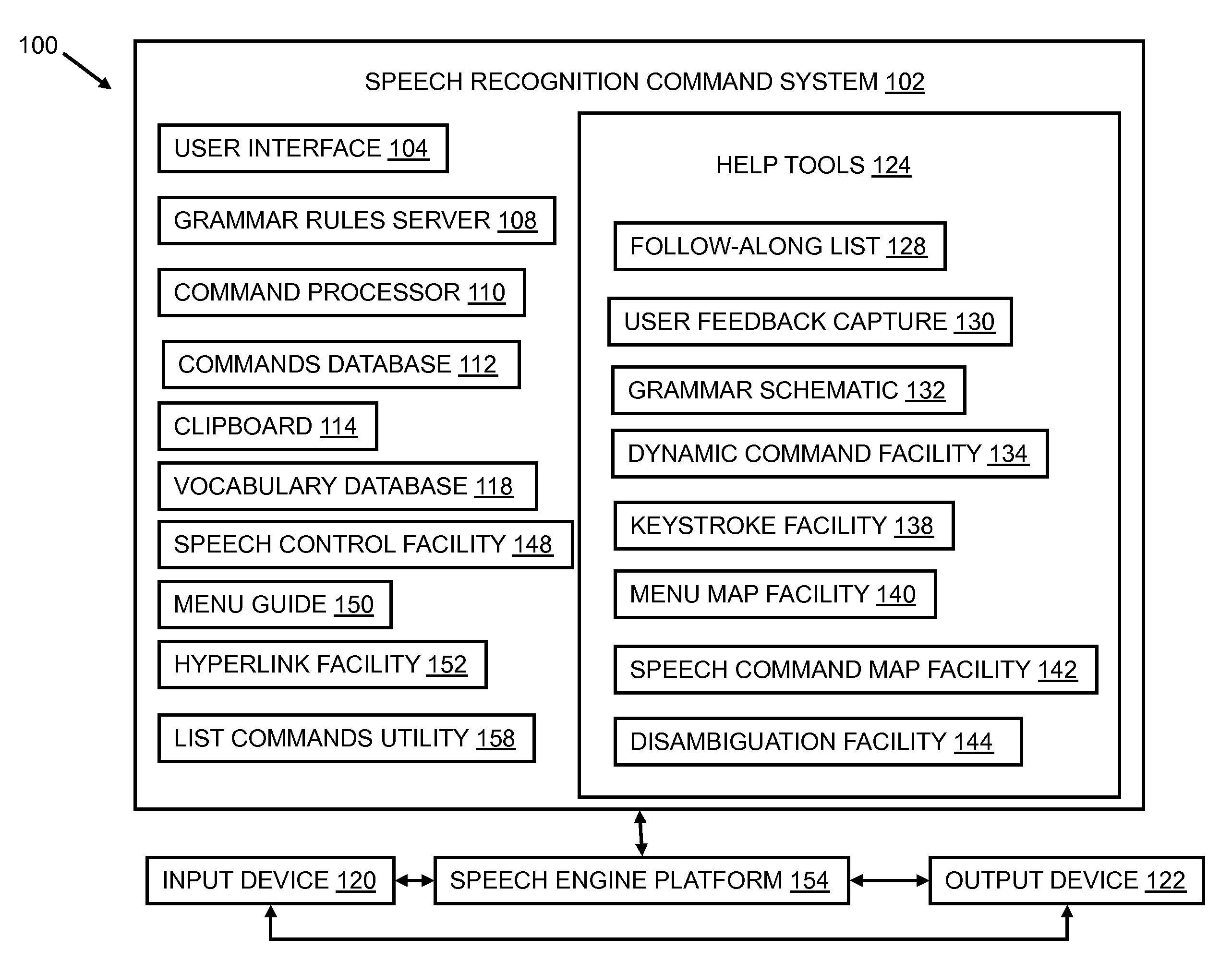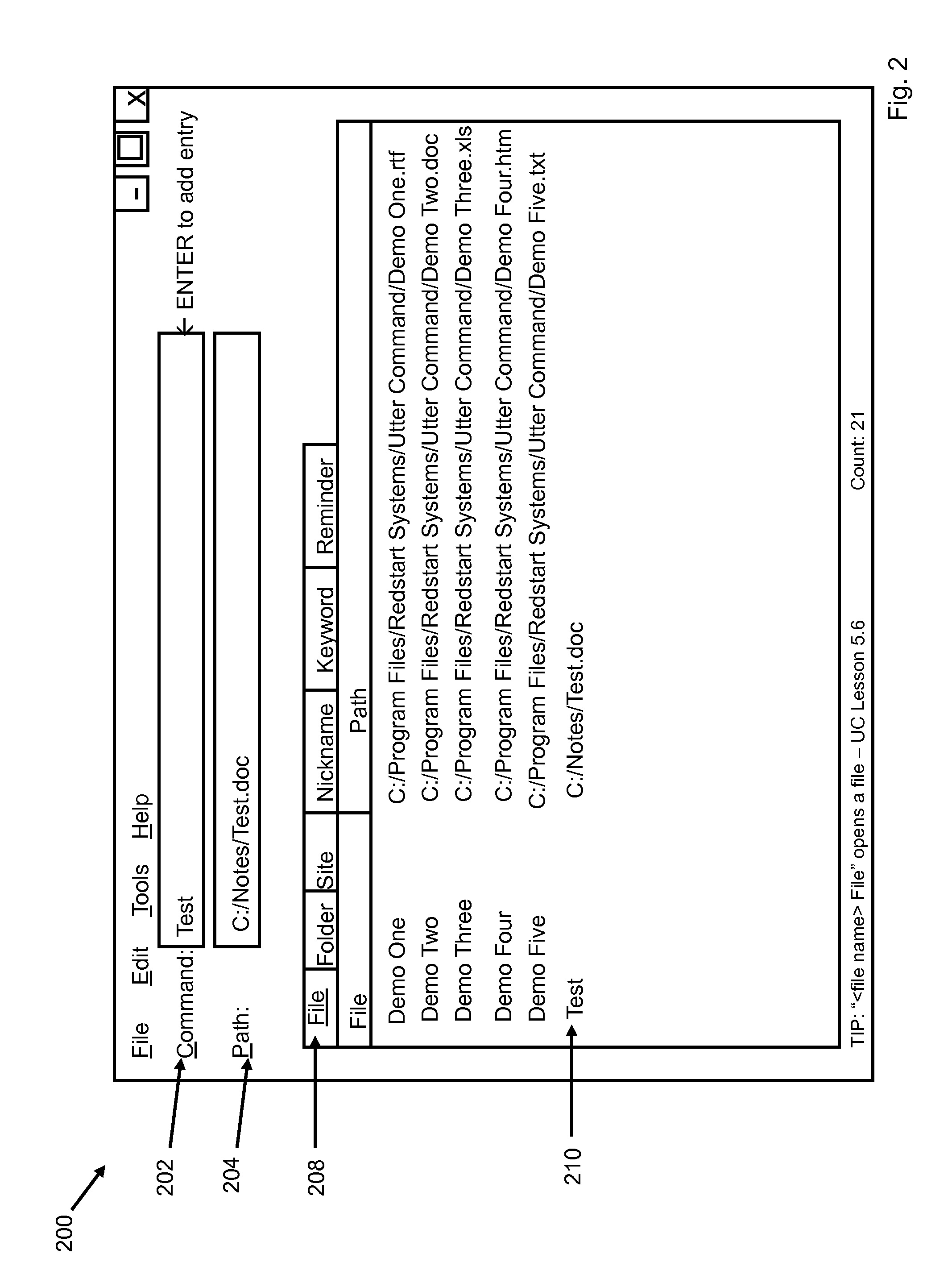[0022]In an aspect of the invention, a
system and computer-implemented method of using multiple cursors in a
speech recognition system may comprise defining a structured grammar for a speech
recognition system for a
computer platform, the structured grammar adapted to enable a user to use a voice command to establish at least two cursor positions with respect to an object of the
computer platform, and defining a voice command by which a user may select at which cursor position an action will be taken, wherein the structured grammar facilitates a
phrase mode such that handling of words in a
phrase is based on a keyword of the
phrase. In the system and method, the structured grammar enables combinatorial voice commands. In the system and method, the voice command output is presented through an
output device. The system and method may further comprise specifying a placement of a cursor with respect to an x-y or x-y-
z coordinate system associated with the object. In the system and method, the voice command is issued through an
input device. In the system and method, the keyword distinguishes between a written and symbolic form of a word. In the system and method, the keyword distinguishes between the full form of a word and its abbreviation. In the system and method, the keyword distinguishes between words that are homophones. In the system and method, the keyword distinguishes between different formats of the date or time. In the system and method, the keyword distinguishes between numbers and number values in combined commands. In the system and method, the keyword distinguishes between moving the cursor then
typing a number and moving the cursor a number of times. In the system and method, the keyword distinguishes between command words and text.
[0032]In an aspect of the invention, a system and computer-implemented method for enabling a user to interact with a
computer platform using a voice command may comprise the steps of defining a structured grammar for generating a global voice command, and defining a global voice command of the structured grammar, wherein the global voice command specifies placement of an object with respect to an x-y or x-y-
z coordinate system, wherein upon receiving voice input from the user the platform recognizes at least one global voice command in the voice input and places the object at the specified x-y or x-y-z coordinates in accordance with the recognized global voice command. In the system and method, the structured grammar enables combinatorial voice commands. In the system and method, the object may be a cursor, a scroll bar, a screen
keyhole, and / or a
robot. In the system and method, the voice command enables independent control of at least two cursors with respect to at least one object of a computer platform. In the system and method, the voice command corresponds to multiple keystrokes. In the system and method, the voice command functionalizes a speech link. In the system and method, the structured grammar enables a phrase mode wherein a keyword of a phrase modifies the meaning of words within that phrase, wherein the mode is automatically terminated at the end of the phrase. In the system and method, the voice command enables building a custom
list of objects.
[0033]In an aspect of the invention, a system and computer-implemented method for enabling a user to interact with a computer platform using a voice command may comprise the steps of recognizing a global voice command in a computer platform, and controlling an object in accordance with the global voice command, wherein the global voice command is defined using a structured grammar that facilitates placement of the object with respect to an x-y or x-y-
z coordinate system using a single voice command. In the system and method, the structured grammar enables combinatorial voice commands. In the system and method, the object may be a cursor, a scroll bar, a screen
keyhole, and / or a
robot. In the system and method, the voice command enables independent control of at least two cursors with respect to at least one object of a computer platform. In the system and method, the voice command corresponds to multiple keystrokes. In the system and method, the voice command functionalizes a speech link. In the system and method, the structured grammar enables a phrase mode wherein a keyword of a phrase modifies the meaning of words within that phrase, wherein the mode is automatically terminated at the end of the phrase. In the system and method, the voice command enables building a custom
list of objects.
[0044]In an aspect of the invention, a system and computer-implemented method for enabling a user to interact with a computer platform using a voice command may include the steps of recognizing a global voice command in a computer platform and controlling a custom
list object function in accordance with the global voice command, wherein the global voice command is defined using a structured grammar that facilitates building a custom list of objects using a single voice command, wherein the custom list object is a screen coordinate. In the system and method, the structured grammar may enable combinatorial voice commands. In the system and method, the voice command may specify placement of a cursor with respect to an x-y or x-y-z coordinate system associated with the object. In the system and method, the voice command may enable independent control of at least two cursors with respect to at least one object of a computer platform. In the system and method, the voice command may correspond to multiple mouse clicks or screen touches. In the system and method, the structured grammar may enable a phrase mode wherein a keyword of a phrase modifies the meaning of words within that phrase, wherein the mode is automatically terminated at the end of the phrase. The keyword may distinguish between moving a cursor then
typing a number and moving a cursor a number of times. The keyword may distinguish between command words and text.
[0048]In an aspect of the invention, a computer-implemented method of the speech
recognition system may include identifying phrases used for discrete sections and descriptions in many examples of a
medical report;
winnowing the phrases to a set of phrases, each unique in meaning;
parsing the phrases, wherein
parsing may include further
winnowing phrases by constructing them using variables; assigning each set of variables a unique name or a wildcard such as “placeholder”; identifying unique, comfortable-to-say 1-2 word identifiers for each phrase including variables that accurately bring the phrase / variable to mind; labeling each phrase as a logical “and” or “or”; grouping identifiers into logical, comfortable, spoken sets (one or more groupings may be identified, appropriate for different user experience levels and coordinated to make it easy for a user to move to the next level); labeling each set as a logical “and” or “or”; and identifying
punctuation locations; comparing identifier words throughout the report to eliminate ambiguities; and constructing text macros that follow the parsed text, enabling the user to speak the identifiers to indicate full,
formatted text. The method may include constructing a mnemonic document so a user can easily read the identifiers out loud to produce a report. The mnemonic document may use a middle dot (•) indicator in order to provide speech instructions for both beginner and advanced users in a single, concise document. The method may be adapted to operate on a portable speech-enabled office or speech stick. The method may be adapted to operate within an application for an
electronic medical record or an electronic health
record. The method may be embodied in an application of a computer platform. The method may include defining a structured grammar for a speech
recognition system of the computer platform, the structured grammar adapted to enable a user to use a voice command to control the application on the computer platform
 Login to View More
Login to View More  Login to View More
Login to View More 


